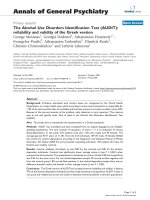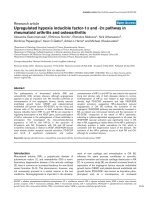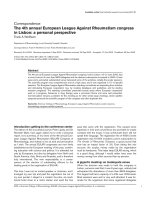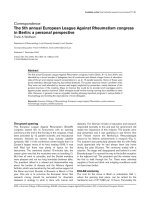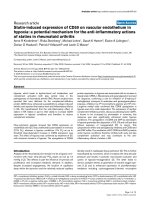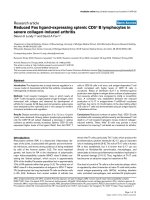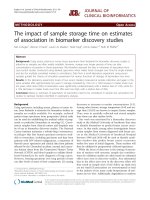Báo cáo y học: "he 4th annual European League Against Rheumatism congress in Lisbon: a personal perspective" pps
Bạn đang xem bản rút gọn của tài liệu. Xem và tải ngay bản đầy đủ của tài liệu tại đây (41.28 KB, 4 trang )
1
ACR = American College of Rheumatology; EULAR = European League Against Rheumatism; IL = interleukin.
Available online />Introduction: getting to the conference center
The editors of this successful journal, Peter Lipsky and Sir
Ravinder Maini, have again asked me to write a personal
report, not a summary, of my views of the 4th annual Euro-
pean League Against Rheumatism (EULAR) Congress of
Rheumatology, and indeed, to be as acid and provocative
as I wish. The annual EULAR congresses are now firmly
established as the European meeting of the year, combin-
ing education with science and politics. It is attended not
only by Europeans, but also by delegates from North and
South America, Asia, Africa and Australia, and is therefore
truly international. The new respectability is a conse-
quence of the election of outstanding officers to the
leading posts in the organization of EULAR.
This time I was not an invited speaker or chairman, and I
arranged my own trip and paid the registration fee out of
my own pocket. I stayed in a modern four-star, air-condi-
tioned hotel close to a metro station and used the free
pass that came with the registration. This caused some
expenses in time and convenience but provided for ample
contacts with the locals. It was unfortunate that I did not
speak their language. The registration fee of €800 (onsite
registration was €1000) included a year’s subscription to
The Annals of Rheumatic Diseases, a good journal that
now has an impact factor of 3.6. Even taking this into
account, the surplus money made by the organization
must be handsome. This helps keep EULAR strong, which
is a good thing, although I would rather have seen the
money coming from other sources than my pension.
A gigantic meeting: an inadequate venue
When the decision was made to hold this congress in
Lisbon, someone said that it was 6 years ago, nobody had
anticipated the attendance of more than 8600 delegates.
The largest hall had a capacity of a little over 2000 seats.
Most sessions were well or very well attended. It was for-
tunate for the organizers that some registered delegates
Correspondence
The 4th annual European League Against Rheumatism congress
in Lisbon: a personal perspective
Frank A Wollheim
Department of Rheumatology, Lund University Hospital, Sweden
Correspondence: Frank A Wollheim (e-mail: )
Received: 9 Jul 2003 Revisions requested: 5 Sep 2003 Revisions received: 22 Sep 2003 Accepted: 17 Oct 2003 Published: 25 Nov 2003
Arthritis Res Ther 2004, 6:E1 (DOI 10.1186/ar1023)
© 2004 BioMed Central Ltd (Print ISSN 1478-6354; Online ISSN 1478-6362)
Abstract
The 4th annual European League Against Rheumatism congress, held in Lisbon, 18–21 June 2003, had
a record turnout of more than 8600 delegates and the abstract submissions increased to 2600. A heat
wave and a somewhat substandard venue hampered some of the activities, notably the poster sessions.
The scientific program was comprehensive and of a high class, and it was organized in 10–12 parallel
sessions. The European League Against Rheumatism standing committees are expanding their activities
and stimulating European cooperation (e.g. by creating databases and guidelines, and by starting
research programs). The standing committees presented several areas where European cooperative
work is in progress. Advances in drug therapy were a prominent theme and were well presented.
Commercialism remains a problem for this meeting as for other similar large meetings, where satellite
symposia surround the scientific program of the congress and often duplicate this.
Keywords: American College of Rheumatology, European League Against Rheumatism, poster sessions,
rheumatology congress, satellite symposia
2
Arthritis Research & Therapy Vol 6 No 1 Wollheim
spent time in cooler environments outside the center. The
architecture of this conference center does not deserve
praise for simplicity or convenience nor, importantly, for
being disabled friendly.
I was put off by the smoking, not least among the friendly
and helpful conference staff. Smoking is a well-recognized
risk factor for acquiring rheumatoid arthritis and for accel-
erating damage in affected individuals. In the program
inviting one to EULAR 2004 in Berlin, in Europe’s largest
congress center, one can read that smoking ‘is only
allowed in designated areas’. That is a definite step back
from Stockholm in 2002. EULAR needs a strict no
smoking policy now!
The ‘ask me’ staff was in general very friendly and abun-
dant, but not very informed. If you had not found the right
page (page 101) in the 125-page program you could get
very frustrated and be late for your executive committee or
editorial board meeting. I was unable to find the Annals of
Rheumatic Disease board meeting in room 1.08 until
running into the unbelievably efficient, competent and
friendly executive secretary of EULAR, Fred Wyss, in the
entrance hall. This detail would do well with some
improvement for Berlin in 2004.
The social arrangements: culture and
generosity
The opening ceremony will be remembered for confusion
and for the negligence of the Minister of Health, who never
showed up. The president, Professor Kalden, had the
pleasure of delivering the usual prizes (or were there
more?) to young and older individuals of merit. We were
also treated to some nice local guitar music and Fado
song. The venue and hot weather, however, impeded the
mingling that usually characterizes the EULAR congress
opening receptions. I did not attend the Gala Dinner
(€120 per person) but was told that the offerings of the
table and the entertainment did not quite match the his-
toric setting in which it took place.
The scientific podium presentations
After such negative preludes, it is a pleasure to acknowl-
edge the scientific committee and its chairman Maxime
Dougados for a well composed and varied smörgårdsbord
of excellent parallel sessions. The 190 invited speakers
were not often reruns from other meetings, but rather con-
tained a number of new names. The clinical sessions were
in the majority. I listened to state of the art presentations
on osteoarthritis and scleroderma, where mostly published
work was presented in a palatable way. I also listened to a
session on treatment of rheumatoid arthritis that started
with a report where the only result presented in the
abstract published in the abstract book stated ‘The data-
base will be locked in early June and assessed immedi-
ately thereafter’. Obviously industry and the coauthors of
this abstract had convinced the scientific committee that
this study should be given a prominent exposure, regard-
less of what the immediate analysis might contain. This is
remarkable and is scientifically unsound.
It was interesting to listen to presentations by Iain McInnes
on very preliminary experiences in targeting IL-15 and by
Sir Ravinder Maini on the significant but perhaps not over-
whelming effects of IL-6 inhibition in rheumatoid arthritis. It
was also interesting to listen to a convincingly negative
trial report of infliximab in patients with Sjögren’s syn-
drome delivered by Xavier Mariette.
The basic sessions I attended were of a high quality and
gave rise to interesting discussions, and the attendance
was good. As already mentioned, most sessions were well
attended and some were even crowded or impossible to
enter. A new and laudable feature was the sessions orga-
nized by the standing committees on the final day of the
congress, dealing with European cooperative initiatives
relating to topics such as ankylosing spondylitis, sclero-
derma, autoantibodies, cytokines, and genomics.
Poster sessions: EULAR must get their
priorities right
The number of submitted abstracts had increased from
around 1800 in Stockholm in 2002 to around 2600
(Table 1). The 148 abstracts with the highest ratings had
been selected for podium presentation. Of the remaining
accepted abstracts 656 were only printed in the abstract
book and 873 were accepted as poster presentations.
The stage was thus set for creation of interesting poster
sessions, featuring the better half of the submitted
abstracts. In Stockholm last year the three poster sessions
featuring some 350 posters were each a very positive
experience, as I wrote previously [1]. The three locations in
the conference center selected by the organizers for
poster presentations this year, however, were extremely
unsatisfactory. They were located in peripheral areas of
the center where temperatures of more than 40°C were
Table 1
The abstract book
Abstract book Number of received/
Meeting thickness printed abstracts*
EULAR Nice, 2000 16 mm, 366 pages ?/≈ 1350
EULAR Prague, 2001 15 mm, 368 pages ?/≈ 1300
EULAR Stockholm, 2002 22 mm, 530 pages ≈1800/1795
EULAR Lisbon, 2003 26 mm, 593 pages ≈2600/1777
*Source: EULAR abstract books. EULAR, European League Against
Rheumatism.
3
prevalent and where the humidity reached saturation. The
poster sessions were scheduled from 12.30 to 2.00 p.m.,
a time also reserved for lunch. Under these circumstances
it was no surprise that only the odd presenter was actually
present at the poster, and I do not blame them.
There was a corresponding paucity of viewers, so the
promising development in Stockholm last year was turned
into a disastrous failure. Poster presenters come to the
congress after months of preparation. It may be their first
exposure to international expertise and to stimulating
experience bridging generations. This is hard to say, but I
must: EULAR gives a wrong signal to the active young
investigators, to the hope of the future. The poster ses-
sions should be the meat and spice of a good congress,
but they were spoilt by providing such a substandard envi-
ronment. Had I been in charge of EULAR I would try to
limit the damage to the presenters in Lisbon not only by
issuing an apology, but also by offering the senior presen-
ter a substantial rebate on next year’s registration. I believe
that EULAR could afford it and that this would convey a
clear message that poster presentations are an important
and vital part of the congress.
Satellite symposia and industry support
The scientific program of the congress started on Wednes-
day at 2 p.m. and ended at 12.30 p.m. on Saturday. The
program featured 10–12 parallel sessions of 90–150 min
each plus the daily poster sessions of 90 min. The total
time allotted to science every full day amounted to 7 hours
including the lunchtime poster sessions.
In addition, attendees could choose between 22 official
satellite symposia, sponsored and arranged by industry and
held in the main venue. The satellites were not concurrent
with any parts of the scientific program, but they occupied
3 hours of time of the first 3 days. They could feature prod-
ucts of the companies or topics they judge to be of interest
and thereby to create goodwill and promote sales. This
could be a very positive thing for both parties. The chair-
men and speakers were selected for eminence as opinion
leaders as well as for pedagogic and scholarly skills. Many
names were also included in the scientific program of the
congress, perhaps addressing the same topic as in the
satellite symposia. Glossy handouts with PowerPoint
reproductions and references were often provided.
These symposia are popular among congress organizers
because they are important sources of income, both through
the direct fee to the organization and by covering costs for
speakers of the congress proper. They may also motivate
industry to support delegates of their choice to attend the
congress. The symposia are regarded by the companies as
major efficient marketing events, provided the congress itself
is attractive enough. They are also often later published as
supplements, and can be cited in marketing material.
EULAR allowed six 90 min slots on 3 days for satellites,
whereas American College of Rheumatology (ACR) sanc-
tions only two such slots; one of these is a late afternoon
and the other is immediately after the end of the meeting.
ACR is thus more restrictive than EULAR. Other societies
are more permissive and allow luncheon satellites, and
others allocate 2 days before or after the congress to satel-
lites. The income from the satellites no doubt increases the
economic strength of EULAR, and allows EULAR to attract
a large and good faculty of invited speakers.
Interaction with industry is an important component of our
professional life and I am not known for shunning work
with or for industry. In fact I have at present signed consul-
tant’s contracts with two companies. But I would have
preferred that the satellites were moved away from the
two main congress days. The additional 3 hours should
then, in part, be used for additional poster viewing.
Perhaps it would reduce the income for EULAR, perhaps
not. But it would increase the chances for success in
attracting not only numbers of abstracts, but a quality of
abstracts in competition with ACR, of that I am sure.
The precongress organization
It was easier to register and to submit abstracts than at
previous EULAR congresses. It was less easy to make
hotel bookings through the organization. Lisbon has many
hotels and I had no problem finding one on the Web. It
was also easy to get information on the program and to
print abstracts before the meeting. I was only under-
whelmed by the map in the congress brochure. One
should have prepared a list of recommended hotels and
provided a readable map indicating their location and
ways of getting from them to the congress venue. I hope
the reason for neglect in this sense was not anticipation
that the majority of delegates arrangements go through
sponsoring companies and therefore are not in need of
such information.
The annual EULAR congress and other
European rheumatology meetings
No other rheumatology congress except ACR’s annual
meeting can claim to compete with EULAR but, notwith-
standing, the national congresses in the European coun-
tries continue to thrive and also to grow. It may be an
important message to EULAR that the proportion of spon-
sored delegates at these national meetings is much
smaller than at EULAR. The other meetings are therefore
less vulnerable to variations in industry support and,
importantly, their more human size and moderate cost
make them attractive to both academic and practicing col-
leagues.
Concluding remarks
Maxime Dougados (and his team) lived up to the expecta-
tions when he took over the chair of the scientific commit-
Available online />4
tee. A new congress is being organized in Berlin next year
in an identical format but with a better venue and a new
scientific committee. The EULAR congress in Stockholm
in 2002 marked a distinct step forward with regard to
overall scientific quality, and in particular a much larger
amount of young rheumatologists and trainees were pre-
senting their work. Lisbon in 2003 was not a step forward,
but the shortcomings that I pointed out, as requested, will
in part be overcome next year. Lisbon stays in our memory
as a charming, slightly exotic place of history. EULAR
remains strong. It has the power to make an input in many
fields of research and practice. Its standing committees
are expanding their work with less bureaucracy than we
see in organizations under the command of the European
Union. But this should not detract from the risks of com-
mercialism and from overt corruption.
Competing interests
FW is a member of the board of directors of OARSI, The
Osteoarthritis Research Society International. This organi-
zation organizes annual international congresses.
Reference
1. Wollheim FA: To keep the catch — that is the question: a per-
sonal account of the 3rd Annual EULAR Congress, Stockholm.
Arthritis Res 2002, 4:E007.
Correspondence
Frank A Wollheim, Department of Rheumatology, Lund University
Hospital, S-221 85 Lund, Sweden. E-mail:
Arthritis Research & Therapy Vol 6 No 1 Wollheim
